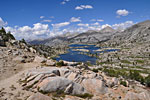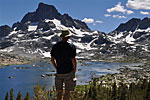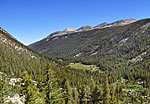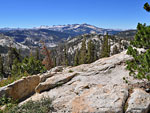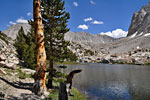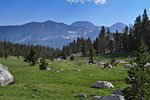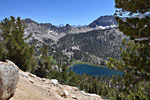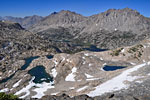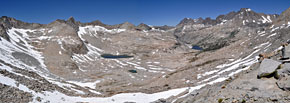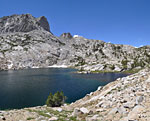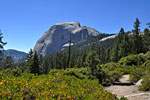 |
|
| John Muir Trail, California 215 miles, 15 days south to north solo across California's Sierra Nevada from Mt. Whitney to Yosemite |
The John Muir Trail (JMT) is arguably America's premiere long distance Scottish-born naturalist and writer John Muir (1838-1914) called the Sierra (Spanish for saw or serrated mountains) Nevada History The John Muir Trail began at the end of the nineteenth century as an idea to connect and protect the remote Sierra wilderness. After extensive lobbying by the Sierra Club, co-founded by John Muir, the Some parts of the JMT are a marvel of engineering - steps blasted out of sheer cliffs, high in the mountains, miles from anywhere. All 215 miles were constructed by hand by work crews who lived in the backcountry for months at a time, hauling supplies by mule - the same way it's maintained by work crews today. When to go Prime hiking season in the Sierra is late Spring to early Fall as the mountain passes become inacessible from snow and ice for many months. The Sierra is known for it's agreeable climate, but midday summer temperatures can rise to 90 degrees (32C) or more. Snow lingers on the high passes throughout the summer and cold weather fronts can bring unseasonably cold temperatures at any time, so carrying multiple layers of non-cotton clothes is advised. Spring snow melt means high water crossings and a deluge of mosquitoes. Late in the summer, most of the mosquitoes have died, but the trade-off is very hot days and the chance of sudden storms. |
Logistics |
Hiking 215 miles in 15 days solo was the most difficult physical thing I've ever done. If I hadn't been training hard for months beforehand, I don't know how I would have made it. This trip report is a journal of what I did to prepare and how it turned out. I've posted a lot of additional photos here. If you're thinking of hiking the JMT, you may find something useful in my experiences that will make your trek easier and more enjoyable, and learn from my successes and slipup's as well. The planning and preparation for a wilderness through-hike can be daunting, and even more so when going it alone. I'm an experienced solo backpacker, but the Sierra is a vast and rugged mountain wilderness and conditions can change dramatically in a short time. It's one thing to plan a trip knowing you can walk 15 miles a day on a flat trail and an altogether different plan when you're hauling a full pack up and down 11,000 ft. mountain passes in thin air, tripping over roots and boulders and fording rushing, icy streams, some times as many as 5-6 a day, day after day. When something goes wrong out here, you need to be prepared and have a backup plan. Nothing should be left to chance - gear, shelter, clothing, water, food and the critical re-supply, emergency plans, weather and conditions, permits and the logistics of hiking hundreds of miles from the car into the wilderness and getting back to it. And yet, there's always the element of risk. |
So I read alot. Park websites and forums and trip reports about river crossings and snow accumulation and storms. I poured over gear lists, weather statistics, water levels and re-supply details. I made lists. I kept notes of everything I could think of. I'd wake up in the middle of the night and jot something down. Which way to go? I climbed Mt. Whitney the year before, so I knew of the preparation, conditioning, exertion and time required to do it, and the logistics of going to the Visitor Center in Lone Pine the day before the hike to pick up a permit and a WAG bag. If you've never climbed Whitney, it's a challenging accomplishment on it's own and you might want to consider north-south to get your trail legs. After many trips in the backcountry, I'm so familiar with Yosemite that it seems like coming home. And I like the idea of going against the flow - there are more people to meet and more campsites available. So it was a natural choice to buck the north-south trend and hike the JMT from south to north. |
| Getting back to the car Next came the logistics of leaving and fetching my car - one of the stickiest points of hiking the JMT solo. I could've searched and found someone local online I could pay to shuttle me, but that would be expensive and the logistics of hooking up could be a problem. I could go the bus to bus route but that's time-consuming - two days - and inconvenient and there's no bus to Whitney Portal. I could hang around the campgrounds, lodges and gas stations and ask everyone that came through for a ride. That's a decent way to get a ride, but it's invasive and intruding is not my style. And most people say no. So I decided to leave my car in Yosemite and hitchhike to Whitney Portal. Hitchhiking means I go on my own time and inconvenience no one. I'd drive from LA to Yosemite Valley, arrive early afternoon and leave my car at the big dirt trailhead parking lot just beyond Curry Village. It's about half a mile from the end of the JMT (or the beginning as the case may be) at Happy Isles. Free parking is included with the $20 park entrance fee. There's no time limit for parking, but the $20 is good only for one week. Feel free to pay another $20 on your way out if you stay in the park longer after you return, but the gate attendants don't stop those leaving. From the Valley, I'd hitchhike the 50 miles up Tioga Rd. to the Tuolumne Meadows backpackers camp, where I'd spend the night. In the morning, I'd hitchhike east out of the park to Mammoth Lakes on Hwy. 395, then south to Lone Pine, over 200 miles total distance. I'd pick up my permit at the Inyo Visitor Center south of town and then try to catch another ride the 2 miles back to town and 8 miles up to Whitney Portal. I figured if I started early and got lucky, I could get from Tuolumne Meadows to Whitney Portal in one day, where I could camp near the trailhead if necessary. |
I've thumbed in Yosemite and other parks before, to return to my car from hikes. It's not difficult to catch a ride with another outdoor enthusiast, as you long as you don't look too creepy and are obviously backpacking. There's an art to hitchhiking I perfected as a teenager - choosing a place where someone can pull over easily, looking friendly and un-threatening (your trek poles look like weapons), getting your gear into their car quickly so they don't lose their place in traffic and where to stand if someone's already hitching there (further down the road). Getting someone to stop is easier in the daylight, when you can be scrutinized from further away. Generally, hitchhiking in the US is to be shunned because of the weirdo factor, but in a National Park, most drivers are vacationers, hikers, climbers and outdoor types who work and play there. It's not uncommon for women to hitchhike here. You can always pass up a ride that doesn't suit you for whatever reason. I often offer some gas money at the end to make people glad they stopped. Because it's easier to catch a ride at the beginning of a long hike, when you're not so grubby and frazzled, it makes more sense to leave your car at the end of your hike and hitchhike at the start. And it's nicer to finish up a trek at your car, with access to everything left behind and immediate mobility, than to concern yourself with getting back to your ride when you're dirty and tired. |
| Permit I got my permit reservation in the Whitney Lottery months ahead of time. You're required to show up in person at the Inyo Visitor Center the day before or early morning of your hike to claim your permit and get the "talk" about Leave No Trace from a ranger. And you get a WAG (Waste Alleviation & Gelling) bag to haul out your poo. You're not allowed to bury it in the fragile ecology of the Whitney Zone. There's a special dumpster at Whitney Portal to drop off your used WAG bag - tons of waste are packed out each year. |
Re-supply logistics There are four re-supply posts to choose from. (see Info) For my southern section, I pick the closest from Whitney - Muir Trail Ranch, and Red's Meadow Resort for the northern section. I pack two five gallon buckets full of lunches and dinners, trail mix and nuts and jerky, cookies and snacks - and mail one to MTR and the other to Red's. I call ahead and to verify both places sell denatured alcohol for my stove, so I don't have to worry about mailing anything flammable or hauling two weeks worth of heavy fuel. |
| Gear and preparations I'm somewhat of a gear junkie. When I'm jones-ing for some new thing I've heard or read about, it's always a thrill to get hold of it and get out on the trail to try it out. I bought some nice gear and tested it on several multi-day trips earlier in the year. I've been slowly getting my pack lighter and lighter, partly in order to carry my heavy Nikon DSLR more comfortably. Although I'm not a true lightweight backpacker - I prefer a certain level of comfort - I have a lot of light gear and a minimalist attitude. I have several precision scales to scrutinize the weight of everything I carry, always looking for some way to reduce it and I tune in to resources online for help in reducing pack weight. I have a nice Garmin Oregon GPS unit but decide not take it because the JMT is such a popular and established foot path that I don't think it justifies the additional weight. I'm glad as I didn't need it. I did use my compass. Food is one of the critical elements of backpacking that can always be improved upon. In general, I try to keep it simple and lightweight. Nothing gourmet, I happily trade pizzazz for weight reduction. For dinners, that I'd been working out regularly all year, 35-40 minutes each morning doing crunches, lunges, pushups, lifting weights, skipping rope and more. Three times a week, I'd run 5 miles at night when it was cool, and did a lot of swimming too. Backpacking is hard on the neck and the back and the shoulders as well as the legs. You need arm strength to pull yourself by your trekking poles on those interminable pass ascents and descents, and to heave your heavy pack up onto your back when you're tired and sore. So all parts need a workout to be ready. I paid close attention to how much food I ate and how much I weighed. I'm at a good weight already and don't want to drop below it much on my trip. |
I monitored the all-important pass conditions on the park service websites and hiking forums every day. The higher passes don't melt until late spring and sometimes into July. Reports say the biggest JMT passes - Trail Camp, Forester, Glen and Muir - had some snow and ice but were clear enough to hike without crampons, which would mean I could hike without heavy boots and ice gear. With the melting snow comes high water levels and potentially treacherous river crossings. The bigger crossings are Evolution Creek, Bear Creek and South Fork of the Kings River, all reported at waist high levels. Crossing a 100' wide, waist deep, icy cold mountain river with a strong current deep in the wilderness by myself was the one aspect of this hike that gave me the most trepidation. The week before, I got my car serviced, paid off my bills in advance, notified friends of my plans and arranged to have my mail picked up. I took out $80 cash for emergencies but planned on using my credit card for the few expenses I'd planned to encounter. I packed and repacked my stuff incessantly, adding and dropping items to reduce weight, until I had all my food and gear finalized. My place was a total mess for days. Then, I packed it all up for the last time. The National Weather Service forecast for the Mt. Whitney area was mostly cloudy followed by a week of clear skies. Good news. I was ready. |
| Day 0July 17 SaturdayLos Angeles - Tuolumne Meadows in Yosemite National Park | ||
|
| Day 1July 18 SundayWhitney Portal - Trail Camp | ||||
|
| Day 2July 19 MondayTrail Camp - Trail Crest - Tyndall Creek | ||||||
|
| Day 3July 20 TuesdayTyndall Creek - Forester Pass | |||||||
|
| Day 4July 21 WednesdayForester plateau - Glen Pass & Rae Lakes | |||||
|
| Day 5July 22 ThursdayRae Lakes - Pinchot Pass - Lake Marjorie | |||||
|
| Day 6July 23 FridayLake Marjorie - Mather Pass - Road's End trail junction | |||||
|
| Day 7July 24 SaturdayRoads End trail junction - Muir Pass - Evolution Lakes | |||||
|
| Day 8July 25 Sunday Evolution Lakes - Muir Trail Ranch | ||||
|
| Day 9July 26 Monday Muir Trail Ranch - Selden Pass - Bear Creek | |||||||
|
| Day 10July 27 Tuesday Bear Creek - Quail Meadows | ||||||
|
| Day 11July 28 Wednesday Quail Meadows - Silver Pass - Purple Lake | ||||||||
|
| Day 12July 29 Thursday Purple Lake - Red's Meadow - Gladys Lake | |||||||
|
| Day 13July 30 Friday Gladys Lake - Garnet Lk. - 1000 Island Lk. - Donohue Pass | ||||||||
|
| Day 14July 31 Saturday Donohue Pass - Cathedral Lakes | ||||||
|
| Day 15Aug 1 Sunday Cathedral Lakes - Yosemite Valley | |||||||
|
| Home | ||
|
| Epilogue | ||
|
Updated Sep. 25. 2011
| BASICS To enjoy the JMT, you'll need the right gear and apparel, backcountry experience, physical conditioning, maps and good information. Hiking in a mountain wilderness is potentially dangerous and even dayhikers should not go up unprepared. Among the things that can go wrong: - Getting lost, group separation - Weather conditions (darkness, rain, hail, ice, snow, lightning, wind) - Landslides, rockfall, forest fires, flash floods - Dehydration, hypothermia, altitude sickness, injury, water/food-born illness - Food/gear stolen or destroyed by animals - Animal attack - bears, mountain lions, rattlesnakes These are in addition to health, medical or fitness related issues one might experience during normal physical exertion outdoors like blisters, poison oak/ivy, ticks & sun burn or losing/forgetting medications or glasses. A permit is required to hike the JMT. You can get it online at the agency which manages your departure trailhead and it's valid for your entire hike. The JMT passes through numerous federal parks and forests and each has rules and regulations to consider. In addition, the Whitney Zone is a specially designated "sensitive environment" around Whitney Portal and Mt. Whitney where even dayhikers need a permit and all must pack out their waste in provided bags. That means if you start the JMT at Whitney Portal, you're required to carry your WAG (Waste Alleviation & Gelling) bag all the way to Muir Trail Ranch or VVR (7-9 days) to dispose of it. You may want to consider holding it in the first day until you exit the Whitney Zone.  A bear-proof food cannister is required in Yosemite and the Whitney Zone, and recommended everywhere in the Sierra. They're bulky and add to your pack weight, but convenient and practical. Sierra bears are becoming more accustomed to seeing bear cans and know to avoid them. It gives me peace of mind to know my food will still be there when I want to leave camp to explore a waterfall or after I turn in at night. A bear-proof food cannister is required in Yosemite and the Whitney Zone, and recommended everywhere in the Sierra. They're bulky and add to your pack weight, but convenient and practical. Sierra bears are becoming more accustomed to seeing bear cans and know to avoid them. It gives me peace of mind to know my food will still be there when I want to leave camp to explore a waterfall or after I turn in at night.Brown bears live throughout the Sierra. They're extremely smart, strong and adaptive. They frequent popular areas where hikers don't practice proper  cooking and food storage, looking for an easy meal. It's extremely rare that they attack humans but they can slip in stealthily in just seconds and steal your food or your pack anytime you leave it unattended. You may see or hear nothing and never know what happened to it. Learning all about bears and other animals that can impact your trip is beyond the scope of this site, but you should know and practice proper food techniques, animal safety and Leave No Trace hiking and camping. cooking and food storage, looking for an easy meal. It's extremely rare that they attack humans but they can slip in stealthily in just seconds and steal your food or your pack anytime you leave it unattended. You may see or hear nothing and never know what happened to it. Learning all about bears and other animals that can impact your trip is beyond the scope of this site, but you should know and practice proper food techniques, animal safety and Leave No Trace hiking and camping.The Sierra Nevada is home to many species of snakes, including dozens of variations of the non-venomous king snake. The only venomous snake here is the Western Diamondback Rattlesnake, which lives in the lower elevations. They like to lie on rocks in the morning sun or hang out in cool shady places during the afternoon. I didn't see even one rattler on my JMT hike but I kept a watch out for them at all times in the lower elevations. There are mountain lions here too. They're a concern for people with small children or pets, but consider yourself lucky if you ever get to see one. |
WILDERNESS / TRAIL CONDITIONS There are dozens of river and stream crossings on the John Muir Trail. The biggest are Lower Evolution Creek, Bear Creek and Kings River south of Mather Pass. Most are relatively easy to ford throughout the summer, but conditions change rapidly after a storm. There are half a dozen bridges over the more challenging creeks. Finding current conditions - water levels, snow on passes, weather, etc - is always a challenge as no one source has them all. Conditions change daily and weekly throughout the season and the weather forecasts are only good for a few days. Boosting your confidence is a balance between gaining knowledge from others and preparing for adverse conditions with the proper gear, experience and attitude. Keep in mind that conditions beyond anyone's control - eg. storms, avalanches or wildfires - may interrupt, re-route, delay or cancel your trek at anytime and you should prepare exit strategies. 1) Ranger stations. First choice should be contacting the various park /forest service agencies the trail passes through - Yosemite, SEKI & Inyo - and speaking with a ranger at the backcountry desk. They usually know of problem spots and get updates from Backcountry Rangers who man stations along the trail in season. Depending on how enthusiastic the info ranger is, you can get a variety of answers, as there's a shared human tendancy to exaggerate the depth of their knowledge. Try to corroborate any info with a second source. 2) Park/Forest service agency websites The official sites have a wealth of info on general conditions, preparations and procedures and offer overall seasonal stats and averages. These agencies are strapped for cash and don't have the resources to update their sites daily or even weekly, but they post timely trail closures and alerts and are a valuable 24/7 source of information. 3) Hiking forums and sites. Read recent trip reports and pose a question to the hiker yourself. I've gotten some of my best info from informed folks who frequent these sites. 4) Speak with other hikers you meet on the trail. They just came from where you're going. Chances are, they can even show you a picture. Also, not everyone on the JMT or PCT is a through-hiker. Maybe they just dropped in and have the very latest forecast and conditions. |
||||||||||||||||||||||
| |
|||||||||||||||||||||||
|
Forums / Info sites |
||||||||||||||||||||||
RESUPPLY A critical decision is weighing how much food and fuel to bring versus how many days it will take to hike between re-supply points. There are only 4 places to re-supply along the entire 215 mile wilderness trail - Tuolumne Meadows and Red's Meadow Resort in the north and Vermilion Valley Resort and Muir Trail Ranch in the center. (Toulumne Meadows, 22 miles from the Yosemite Valley trailhead, is more of a starting point than a re-supply.) These privately run businesses collect and store 5 gallon re-supply buckets for JMT hikers for a fee, as a side business. Yes, you can mail a plastic bucket at the post office. Check each business for specific rules about payment, delivery, weight, labels, etc. You'll need to mail your bucket far in advance to make sure it arrives on time. A critical decision is weighing how much food and fuel to bring versus how many days it will take to hike between re-supply points. There are only 4 places to re-supply along the entire 215 mile wilderness trail - Tuolumne Meadows and Red's Meadow Resort in the north and Vermilion Valley Resort and Muir Trail Ranch in the center. (Toulumne Meadows, 22 miles from the Yosemite Valley trailhead, is more of a starting point than a re-supply.) These privately run businesses collect and store 5 gallon re-supply buckets for JMT hikers for a fee, as a side business. Yes, you can mail a plastic bucket at the post office. Check each business for specific rules about payment, delivery, weight, labels, etc. You'll need to mail your bucket far in advance to make sure it arrives on time. The greatest distance between re-supply points is that between Whitney Portal and Muir Trail Ranch, over 100 miles, typically requiring 7-8 twelve-fifteen mile days. Many plan on 9-10 days between these two points, carrying more weight, traveling slower and stopping more often. |
Most re-supply at Red's Meadow Resort because it's situated at the common 4-6 day interval from both north trailheads and south re-supply outposts. One of the perks of these re-supply posts is the giveaway food and toiletries - astonishing amounts of unused good stuff that hikers leave behind because they mailed more than they can carry away. It's entirely possible to avoid sending any re-supply bucket and get more food than you'll need to continue your trip for free, although it's usually the more mundane, generic, heavy and home-made items that get left behind. Most will receive and deliver mail, provide internet connectivity and sell common hiking supplies like stove fuel and bug spray. All allow trash dropoff. |
John Muir Trail re-supply outposts
|
CAR SHUTTLE It's approximately 250 miles between Yosemite Valley and Whitney Portal by road. With 2 drivers, you can leave one car at the beginning and one at the end. Most solo hikers leave their car at one end and arrange a ride to the other. There are local people who will do this. Check the forums above. Long-term parking is free at Whitney Portal at a large multi-section parking lot. However this lot fills up quickly in the summer. Because of bear prowls, you are not allowed to leave food, coolers, toiletries or scented items in your car - they must be stored in one of the numerous steel bear boxes on the perimeter. Plan on having nothing or minimal, small items to leave in the bear box as they are often full and anyone can open and go through them. In Yosemite, the best parking lot for JMT hikers is the trailhead parking for Mist Trail, a large dirt lot just east of Curry Village, 1/2 mile from Happy Isles, the beginning of the JMT. This lot fills up early each day with HalfDome and Mist Trail hikers. You'll have better luck finding a space in the afternoon. Sometimes they leave a "Lot Full" sign on the road even after spaces become available, so always have a look first if possible. You can also park in the Curry Village parking lot. Food, coolers and toiletries must be stored in the steel bear boxes. Alternatively, you can take the free shuttle bus from anywhere in the park to the Happy Isles stop. Service begins at 7am. |
Bus service: You can get most of the way between Yosemite and Whitney Portal by using public bus service if you plan ahead and have 2-3 days on each side of your trip. From Yosemite Valley or Tuolumne Meadows, you can take the YARTS bus to the town of Mammoth Lakes on Hwy. 395. From there, you take the CREST bus, operated by Eastern Sierra Transit Authority, to Lone Pine. In the past there has been only one CREST bus a day and it stops at every town on Hwy. 395. The YARTS bus arrives in Mammoth Lakes after the CREST bus leaves, so it will take 2 days by bus in each direction. The YARTS bus requires reservations. The CREST bus doesn't offer reservations but the dispatcher assures seating is available. From Lone Pine, there is no public transportation between town and Whitney Portal (8 miles). Yosemite - Mammoth Lakes YARTS (Yosemite Area Regional Transportation System) 369 West 18th Street, Merced, CA 95340 877.989.2787 YARTS.com Mammoth Lakes - Lone Pine Eastern Sierra Transit Authority 800.922.1930 EasternSierraTransitAuthority.com |
More photos in the Trip Report top of page
TOP![]() Hikes Index
Hikes Index
Since 11.08


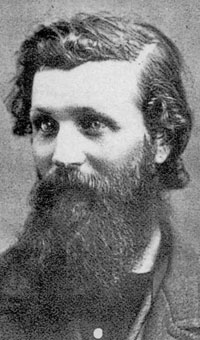






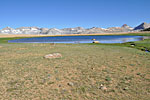
 hordes of mosquitoes swarmed from every direction. I was the only thing to eat for miles apparently, and every bug at the lake set upon my heat signature. My soft shell, gloves and bug net became survival gear as I set up my tent. They surprised me with their numbers and viciousness but I didn't get bitten much. Of all my treks in the Sierra, I've never seen so many mosquitoes. There was simply no outdoor enjoyment to be had this evening under the relentless assault, so I climbed into the tent and napped until dark, when I could get out and move about freely again.
hordes of mosquitoes swarmed from every direction. I was the only thing to eat for miles apparently, and every bug at the lake set upon my heat signature. My soft shell, gloves and bug net became survival gear as I set up my tent. They surprised me with their numbers and viciousness but I didn't get bitten much. Of all my treks in the Sierra, I've never seen so many mosquitoes. There was simply no outdoor enjoyment to be had this evening under the relentless assault, so I climbed into the tent and napped until dark, when I could get out and move about freely again. 









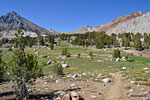








 needed to rest for the long uphill the next day. I didn't hike for a week into the wilderness just to share my campsite with lazy, inconsiderate morons. What was I thinking? The lesson for me and everyone - don't allow anyone to share your campsite if other sites are available. Just say no!
needed to rest for the long uphill the next day. I didn't hike for a week into the wilderness just to share my campsite with lazy, inconsiderate morons. What was I thinking? The lesson for me and everyone - don't allow anyone to share your campsite if other sites are available. Just say no!
